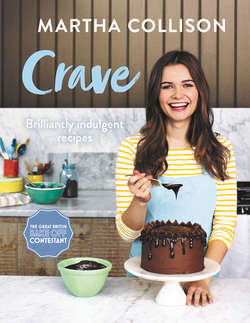Читать книгу Crave: Brilliantly Indulgent Recipes - Martha Collison - Страница 8
ОглавлениеIngredients
Fresh, good-quality ingredients raise an average bake to a great one and really make it sing. These are my top storecupboard ingredients which I make sure I always have in stock.
Eggs
The humble egg is the most versatile ingredient in baking. It can be used to bind mixtures, aerate puddings, thicken custards and set into firm structures like meringue. I use medium free-range eggs in my recipes unless otherwise stated. Fresh eggs yield the lightest, fluffiest bakes, so use your freshest eggs for making cake batters. Slightly older eggs will make brilliant meringues or macarons. Store your eggs at room temperature for baking – egg whites and yolks combine much more easily at room temperature and will disperse through batter more smoothly.
Butter
Butter is my favourite ingredient by far to use in baking. Its rich, full flavour is what makes caramels so moreish and ganache so smooth. I always use salted butter in baking unless otherwise specified. I find the saltiness is the perfect partner for sweet and savoury recipes and it’s what I spread liberally on my toast, so its something I always have to hand. Unsalted butter is necessary in some cases – buttercreams and delicate pastries can be overwhelmed by salt, so keep this in mind. Use the butter at the temperature that the recipe states – cold for pastry and room temperature for sponge or buttercream – as this can make or break a bake.
Milk
Many chefs specify whole milk for baking, but if you don’t normally have it in the fridge, don’t buy it especially unless the recipe specifies it. Whole milk has a high percentage of butterfat (a minimum of 3.5%) so can yield a creamier result, but semi-skimmed milk (1.5–1.8% butterfat) will still do the job. I often use semi-skimmed milk to make bakes, and it works perfectly.
Raising agents
Baking powder and bicarbonate of soda are the two raising agents I use to make bakes rise or spread out. For any chemistry geeks like me who want to know how they work, here’s a brief explanation. A reaction between an acid and a base creates carbon dioxide bubbles, which cause a cake mixture to rise. Bicarbonate of soda is a base, so an acidic ingredient needs to be present in the mixture for it to react with to create the bubbles. Lemon juice, buttermilk or cocoa powder, among many others, do the trick. Baking powder is a combination of bicarbonate of soda (a base) and cream of tartar (an acid), so both the acid and base required for the reaction are already present, and your bake will rise with no further assistance.
Salt
There are many different kinds of salt available, so it can be confusing to know what’s best for baking. Fine table salt is generally what’s called for, as its fine texture can evenly disperse throughout bread dough and cake batter. Sea salt has a better flavour and is perfect for adding a final flourish to caramels, breads and snacks.
Sugar
From clouds of white icing sugar to clumps of moist, fudgy, soft, dark brown sugar, there are so many varieties of the sweet stuff that, when used in baking, produce completely different results. Caster sugar is the most commonly used in this book as its fine texture and neutral flavour provide a great base for most sweet recipes. I try to buy Fairtrade sugar to ensure that it is grown and harvested ethically (it is rarely pricier than standard sugar).
Yeast
I use fast-action dried yeast (also known as instant, easy-blend or easy-bake yeast) in baking as I find it the easiest to work with. It doesn’t need to be activated with warm water or milk, it can just be added straight to dry ingredients and will work perfectly. Always check the use-by date on packs of yeast, as out-of-date yeast may fail to make your bread rise.
Flour
I use a mixture of self-raising flour and plain flour in this book, as I always seem to have a glut of both flours, and it seems a shame to let one go to waste. If a recipe specifies self-raising flour but you don’t have any, you can easily substitute it by adding 1/2 a teaspoon of baking powder to 100g plain flour and using this in its place. Strong bread flour is essential in bread-making and some pastries as it contains a higher level of gluten necessary for maintaining structure.
